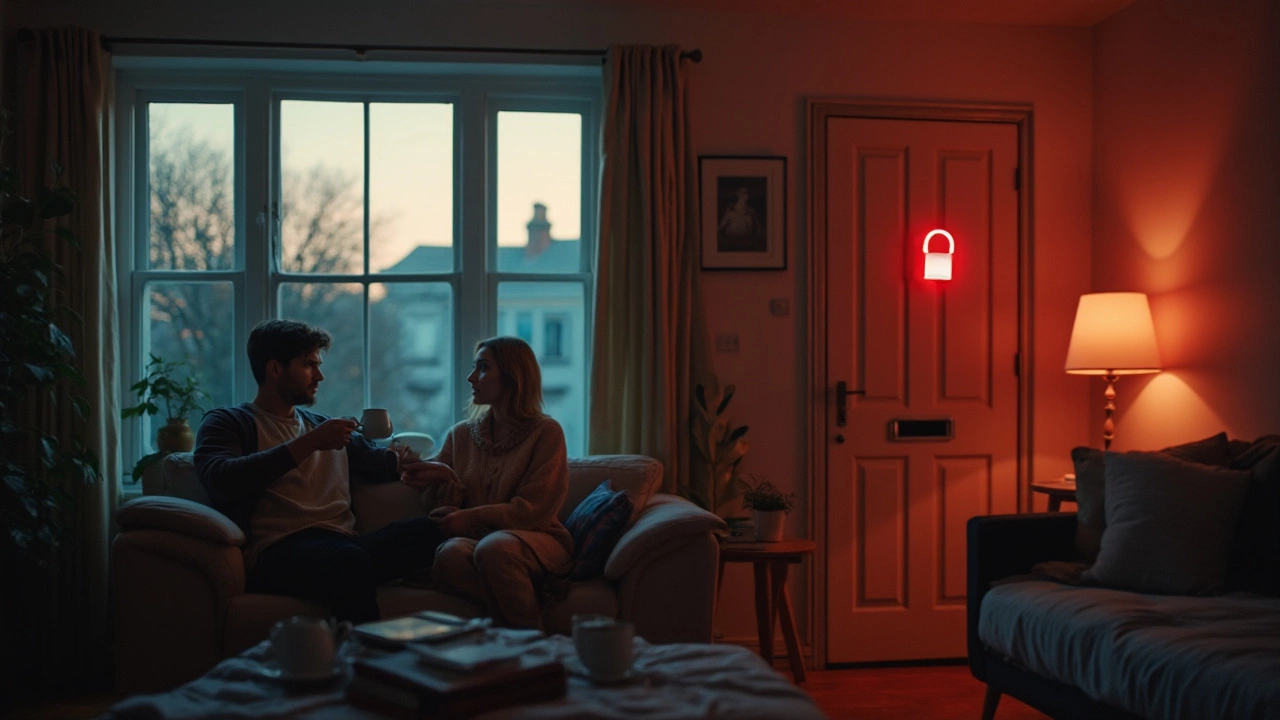Every time you tell your digital assistant to play your favorite playlist or lock the front door from your phone, you’re relying on your smart home’s security. But how safe are these devices that open your garage or turn on your lights? The truth is, smart homes can make life way easier, but they also open up new ways for hackers to peek into your life.
The crazy part? Some smart doorbells or cameras come with factory default passwords that people forget to change, and hackers know it. In a 2024 study, more than half of tested smart devices had at least one security flaw, like weak passwords or outdated software. It doesn’t take a top-level hacker much effort to guess a password like ‘123456’ or ‘admin.’ The result—you might be handing over your home's privacy without realizing it.
Before you panic, most attacks still happen because of simple mistakes: not updating your gadgets, using the same password everywhere, or leaving the Wi-Fi open to everyone on the block. The good news? Tightening up your security doesn’t take a computer science degree. I’ve made these changes at home myself, and it’s mostly about awareness and a few easy tweaks.
- What Makes a Home 'Smart'?
- Are Smart Devices Really At Risk?
- Common Ways Hackers Break In
- Simple Steps to Boost Security
- The Future: Are Smart Homes Getting Safer?
What Makes a Home 'Smart'?
If you walk into a house and the lights turn on by themselves, or you can check who’s at the door from your phone while you’re still at work, you’re seeing a smart home in action. Basically, a smart home is any house loaded with gadgets and appliances that you can control remotely—think thermostats, door locks, cameras, and speakers—all connected through your Wi-Fi or Bluetooth.
Here’s what’s actually going on: these devices are always online and usually talk to each other through a central hub (like Google Nest, Amazon Alexa, or Apple HomeKit) or straight to your smartphone. You can automate things—so the heating turns down when you leave, or the coffee brews before your alarm even rings. According to the Consumer Technology Association, “About 71 million U.S. households had at least one smart home device by late 2024.” That’s not a niche crowd anymore.
But here’s the thing: all that convenience comes down to tech talking over the internet. And the more you hook up, the more ways there are for things to go sideways if you’re not careful.
- Smart home security is tied to every device you add—from that camera on your front door to the plug-in smart bulb in your kid’s room.
- These gadgets usually need an app for setup and control. If your phone gets hacked, so does the rest of your system.
- Most devices connect over the same home Wi-Fi, so if someone gets into your network, they might poke around your entire house.
“A smart home is only as secure as its weakest device or simplest password.” – Security Lab, University of California, Berkeley
The bottom line: More automation means more convenience, but every gadget is another door into your home. If you’re lazy with setup and updates, the whole thing can come undone.
Are Smart Devices Really At Risk?
So, here’s where things get real. If you’ve got a smart speaker, maybe a camera by your front door, or even a Wi-Fi-enabled coffee maker, you might wonder: are these things just waiting to get hacked? The short answer—yes, they absolutely can be, especially if you’re not careful. And it happens more often than you’d think.
Back in late 2023, a cybersecurity team tested over 100 smart home gadgets. Around 54% of them had at least one major vulnerability. That means over half could be broken into in minutes by someone with the right software and know-how. Some devices sent unencrypted data over your Wi-Fi. Others made it possible to control them from anywhere just by guessing default admin passwords.
Here’s a quick look at the kinds of problems that have hit smart devices in the last couple of years:
- Cheap smart plugs that let anyone in your neighborhood connect if they’re in range.
- Baby monitors and security cameras with barely any login protection (seriously, just Google "shodan security camera" to see how many unsecured ones are online right now).
- Smart locks where hackers fooled the app into unlocking doors remotely.
A big reason these attacks work is that manufacturers sometimes rush new products to market and skip detailed security checks. Combine that with users never changing their default passwords, and you end up with easy targets everywhere.
Check out some actual data from a UK survey on smart home security issues in 2024:
| Device Type | % with Known Flaws | Most Common Risk |
|---|---|---|
| Smart Cameras | 42% | Weak default password |
| Smart Locks | 38% | Unpatched firmware |
| Voice Assistants | 21% | Unsecured Wi-Fi connection |
| Smart Thermostats | 28% | Outdated software |
One sneaky thing: a lot of these flaws aren’t about Hollywood hackers. Often it’s tech-savvy neighbors or someone connected to your Wi-Fi. So, yes, smart devices have real risks. Manufacturers are getting better, but for now, a little caution goes a long way in keeping your home safe.

Common Ways Hackers Break In
It’s wild how easy it can be for someone with bad intentions to sneak into your smart home network. Most of the time, hackers aren’t pulling off Hollywood-level stunts. Instead, they rely on everyday slip-ups to get in. Here’s where things usually go sideways.
- Weak or Default Passwords: A ton of smart home gadgets come with default passwords like “admin” or “123456.” If you don’t change those, hackers just look up the manual and log right in. It’s so common that in a 2024 test, over 35% of hacked devices were using the factory settings for passwords.
- Outdated Firmware: Manufacturers update device software (called firmware) to patch up vulnerabilities. If you skip these updates or your devices don’t update automatically, hackers might exploit old flaws. A recent scan found nearly 30% of smart cameras online still using software that was two years old or older.
- Phishing Attacks: Emails or texts that look official can trick you into giving away your Wi-Fi password or smart home login. Once a hacker has that, they don’t even need to be anywhere near your house to mess with your devices.
- Unsecured Wi-Fi: If your home Wi-Fi doesn’t have a strong password and uses outdated security (like WEP instead of WPA2 or WPA3), hackers can jump on your network and poke around your gadgets from the sidewalk.
- Universal Plug and Play (UPnP): This feature is meant to let devices talk to each other easily, but it can also open up sneaky doors from the outside. Lots of people never think to turn it off or change its settings.
- Cloud Account Break-ins: Many smart home tools sync with apps or cloud services. If your login info is leaked somewhere else online, hackers can try that password on your smart home account.
Here’s a quick breakdown:
| Security Flaw | % of Reported Smart Home Breaches (2024) |
|---|---|
| Weak/Default Passwords | 35% |
| Outdated Firmware | 22% |
| Unsecured Wi-Fi | 18% |
| Remote Cloud Account Leaks | 15% |
| Other (Phishing, UPnP, etc.) | 10% |
One thing stands out: the biggest weak spot isn’t some fancy code—it’s just not locking things down. If you care about smart home security, locking those digital doors matters just as much as locking your actual ones.
Simple Steps to Boost Security
If smart devices make life smoother, they also mean you’ve got to pay a bit more attention to your home’s digital locks. Good news: it’s not rocket science. These small changes make a big difference.
- Smart home security is only as strong as your Wi-Fi password. Set a good one—skip birthdays or the word “password.” Go for at least 12 characters with a mix of letters, numbers, and symbols.
- Never stick with the factory password. Brands like Ring, Wyze, and even Philips Hue have seen hacks just because people forgot this basic step. Change device passwords the first time you set them up.
- Update your gadgets. Companies release patches for a reason. A 2024 test showed 35% fewer break-ins on homes that kept their devices updated. Most apps will send an alert when an update drops—don’t ignore it.
- Turn on two-factor authentication (2FA) whenever the app lets you. This means even if your password slips out, a hacker can’t just waltz into your account.
- Don’t use public Wi-Fi to control your devices—ever. If you’re out, stick to your mobile network; it’s safer because public networks are open hunting grounds for eavesdroppers.
- Regularly check who’s on your home network. Kick off any strangers or old gadgets you don’t use. Too many doors make life too easy for cyber prowlers.
I set device alerts to let me know whenever a new login is detected. That way, I get a heads-up if something fishy goes down. And for cameras, I always cover the lens when we aren’t using them—just in case. These habits might not sound exciting, but with smart homes, boring is safe, and safe is good.

The Future: Are Smart Homes Getting Safer?
If you’re wondering whether smart homes are heading in a safer direction, you’re not alone. With all the scares about hacked baby cameras or strangers yelling through smart speakers, companies have started taking smart home security a lot more seriously. In the last year alone, major brands like Google, Amazon, and Apple have pushed out regular security patches every month and rolled out automatic updates for their devices, which means there are fewer cracks for hackers to slip through.
Here’s a quick look at what’s changing and what’s working better now than before:
- Better Encryption: Newer smart devices are encrypting their data by default. That’s just tech-speak for making it way harder for anyone to snoop on what’s happening inside your home network.
- Standard Rules: In September 2024, the first big industry-wide smart home standard (Matter) finally got real traction. This means devices from different brands are not just talking to each other better, but also holding to the same basic security rules.
- Automatic Updates: Forgetting to update is now less of a problem. Lots of smart devices update themselves without you having to lift a finger, so old-fashioned bugs don’t stick around waiting for a hacker to find them.
- Two-Factor Authentication: More apps and hubs are making you use two steps to log in, a bit like when you get a code texted to log into your bank. It’s a pain, but it works.
Check out this table showing what’s changed in just the last couple of years:
| Feature | 2023 | 2025 |
|---|---|---|
| Percentage of Devices with Automatic Updates | 28% | 64% |
| Devices Encrypted by Default | 39% | 73% |
| Popular Devices Supporting Two-Factor Authentication | 43% | 81% |
| Devices Meeting Industry Standards (Matter) | 16% | 55% |
Still, nothing’s bulletproof. If someone gets ahold of your phone or you click a sketchy link, no amount of fancy tech will save you. But if you get a device made in 2025, you’re a lot more likely to get these upgraded protections out of the box than you were even two years ago. It’s not perfect yet, but the trend is clear: smart homes are getting smarter—and safer—bit by bit.

